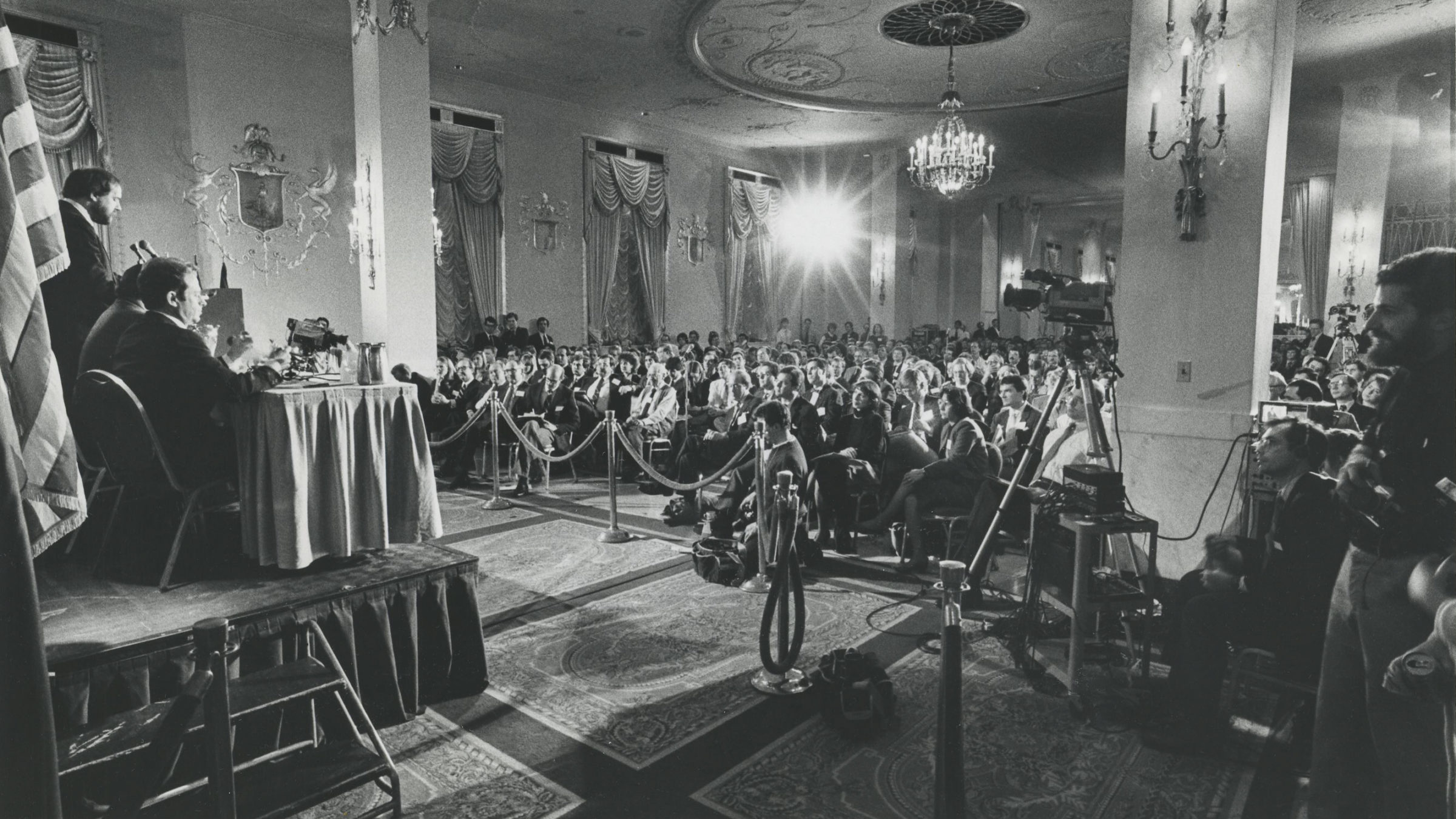In April 1982, there was a conference held at Yale Law School titled “A Symposium on Federalism: Legal and Political Ramifications.” It was the first national meeting of the Federalist Society, composed entirely of conservative law students and academics, mostly from a handful of elite schools.
They were reactionaries in the truest sense, defined by what they opposed: the purported judicial activism of liberal judges. The American right wing had spent much of the mid-century fuming over the rulings of the Supreme Court under Chief Justice Earl Warren. The Court had outlawed racial segregation, enhanced voting rights, protected the rights of criminal defendants, and enhanced citizens’ rights to criticize the government. Even after Warren retired and President Richard Nixon had appointed several purportedly conservative justices, the Court found a constitutionally protected right to abortion in Roe v. Wade in 1973.
Conservatives were reeling. To say they disagreed with these decisions is to understate the scope of their concern. A judiciary prepared to enhance and vindicate civil rights was not just distasteful; it was an existential threat to the conservative project. The right spent much of the 1970s articulating their response. Robert Bork, then a professor at Yale, published a short article titled “Neutral Principles and Some First Amendment Problems” in 1971, outlining his position that the modern Court was driven by its own values rather than legal principle. In 1976, Justice William Rehnquist published “The Notion of a Living Constitution” in the Texas Law Review, wherein he decried the idea that our interpretation of the Constitution might evolve over time.
Steadily, conservative legal scholars coalesced around a rigidly formalistic theory of legal interpretation, the core of which was originalism—the idea that the Constitution should be interpreted as it was originally understood. The concept was fundamentally reactionary; by tethering our interpretation of the Constitution to the past, any emerging jurisprudence would be inherently anti-progressive.
Having cobbled together something that looked like an academic theory, the movement turned to organizing. And that brings us to that little symposium at Yale. Whether they knew it or not, those dorks were destined for greatness. The Federalist Society in 1982 was little more than a consortium of like-minded law students and professors. By the end of the decade, it was one of the most powerful legal organizations in the country, receiving generous funding from billionaires and open support from Republican politicians. During the same period, evangelicals had seized power within the Republican Party, and made their opposition to abortion the heart of its platform. The newly constructed conservative legal movement offered them something they couldn’t provide themselves: an objection to Roe predicated on more than just moral outrage.
Roe’s importance to the right became twofold. To the Republican base, it was a symbol of moral decay. To the conservative legal movement, it was a symbol of judicial overreach—of a progressive vision of the Constitution that had drifted too far from the shores of our humble founding.
The first full-throated attempt to overturn Roe came in 1992, in Planned Parenthood v. Casey. It was thwarted when three more moderate Republican-appointed justices—Sandra Day O’Connor, David Souter, and Anthony Kennedy—banded together with the Court’s liberals to weaken Roe but keep its core holding in place. Liberals cautiously rejoiced, but the conservative legal movement had learned a lesson. Preventing leftward drift on the Court became a top priority, and the vetting process for judicial nominees became ferocious. Federalist Society allies helped sink the nomination of Harriet Miers, President George W. Bush’s White House Counsel, in 2005, uncertain of her conservative bona fides. From there, every subsequent Republican nominee would have the organization’s seal of approval, if not its outright endorsement.

Federalist Society members assemble at the Mayflower Hotel in Washington, D.C. for the organization’s first Lawyers’ Convention in 1987 (Ray Lustig/The Washington Post via Getty Images)
The liberal legal academy has been caught off-guard by today’s Court. It’s not that the American right has been cagey about its intentions; opposition to abortion has been part of the official Republican platform since 1976. It’s that many legal analysts and scholars have long believed that standing somewhere between the courts and our collective civil rights is an invisible wall: the “rule of law.” Conservative judges have for decades held themselves out as the purveyors of an impartial justice, guided only by the contours of the law itself. They framed their embrace of originalism not as a thinly-veiled effort to center reactionary ideals in legal analysis, but as a good-faith attempt to root American law in something more tangible than the whims of judges. Many liberals, institutionalists at heart, were happy to believe them.
Recent events seem to have begun the long process of disabusing liberals of these notions. During oral argument in Dobbs v. Mississippi, a case challenging Mississippi’s ban on abortions after 15 weeks, the conservative justices could barely contain their contempt for Roe. Justice Samuel Alito compared the case to Plessy v. Ferguson, the 1896 case that upheld racial segregation. (Alito is under the mistaken impression that, had he been alive at the time, he would have been an opponent of segregation.) Barely a week later, the Court gave its blessing to SB8, Texas’s attempt to use procedural maneuvering to enforce a flagrantly unconstitutional anti-abortion regime. Most observers were able to read the writing on the wall: Roe is probably toast.
Still, there is a tendency among Court-watchers to hem and haw over the particulars of the Court’s jurisprudence. Lawyers are trained to pay attention to details, and it leads to many thinking that the details are what matters most. As a result, some get tied up in jurisprudential fineries. Although he’s no longer the median justice, several outlets remain enthralled with the minutiae of Chief Justice John Roberts’s maneuvering. The New York Times and Politico highlighted Roberts’ purported search for a “middle ground” in their coverage. Joan Biskupic, a CNN legal analyst, published a piece titled “John Roberts has a plan that would gut — yet save — Roe v. Wade. Can it work?” (In Biskupic’s metaphor, Roe is presumably a type of animal that can survive without organs.) These analyses sacrifice coverage of the Court’s ends for almost ceaseless discussion of its means.
It may be that liberal observers were lulled into a false sense of security by the nature of the Court’s past conservatism. Republican-appointed justices have held a majority on the Court since 1969, after all, and the past several decades were spent with a conservative as the median justice. But the pragmatism and occasional moderation of Kennedy and O’Connor are relics of a past generation of legal conservatism. The new generation is different. By the time Justices Neil Gorsuch, Brett Kavanaugh, and Amy Coney Barrett were in law school, it was Republican orthodoxy that activist liberal judges had run amok on our precious Constitution, leaving a path of destruction (read: civil rights and liberties for women and minorities) in their wake. They were baptized in right-wing ideology. Counting on their moderation is a fool’s errand.
The Court’s recent jurisprudence has exposed anyone who believed a conservative Court would eschew politics and embrace moderation as a sucker. The conservatives are not constrained by the rule of law or any other abstraction. They are fulfilling their destiny, closing out a narrative arc half a century in the making. Conservatives manufactured a hegemonic judicial apparatus with the specific purpose of attacking a progressive constitutional order that has Roe at its center. It will be jarring to witness this Court dismantle the protections that so many have taken for granted for so long. But that is what it was built to do.

